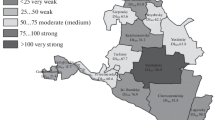Abstract
This article presents the results of long-term studies of the influence of such an anthropogenic factor as animal grazing on the development of desertification in the Astrakhan region. The purpose of the study was to develop scientifically substantiated resource-saving loads of farm animals on pasture ecosystems of the Astrakhan region (AO) by administrative districts. The objectives of the study included conducting geobotanical monitoring of biocenoses of natural arid pastures; determination of the capacity of used pastures, determination of the actual grazing load, and development of science-based pasture loads. The calculations were carried out using the Practical Guide of the All-Russian Research Institute of Fodder “Norms of loading pastures in the Caspian region” (1995). As a result, it was found that in the Astrakhan region, as a result of an increase in the anthropogenic factor, namely the unsystematic and uncontrolled use of natural semi-desert pastures for animal grazing, when the actual load of pastures does not correspond to their capacity (by 2–6 times), the desertification process is activated. Nonoverrun and slightly overrun pastures have been preserved on 35% of the area of the studied fodder lands, medium and heavily overrun pastures occupy 43 and 22%, which indicates a more than five-fold increase over the past decade.



Similar content being viewed by others
REFERENCES
Keller, B.A., Flora of the Russian steppes, semi-deserts and deserts. Ecological and phytocenotic essays, Trudy Instituta po Izucheniyu Prirody i Khozyaistva Zasushlivykh Pustynnykh Oblastei Rossii (Voronezh), 1923, vol. 1, no. 1.
Kulik, K.N., Rulev, A.S., and Yuferev, V.G. Geoinformation analysis of desertification dynamics in the territory of Astrakhan oblast, Arid Ecosyst., 2015, vol. 5, no. 3, pp. 134–141.
Kulik, K.N., Bulakhtina, G.K., and Tyutyuma, N.A., Study of factors of influence of melioratory-fodder forest plantations on arid grazing ecosystems, Trudy Sankt-Peterburgskogo Nauchno-Issledovatel’skogo Instituta Lesnogo Khozyaistva, 2021, no. 2, pp. 28–39.
Mukhortov, V.I., Vlasenko, M.V., and Bulakhtina, G.K., Problems of conservation and rational use of pasture lands in the arid zone of the North-Western Caspian Sea region, Vestnik Rossiiskoi Akademii Sel’skokhozyaystvennykh Nauk, 2010, pp. 346–349.
Normy nagruzki pastbishch Prikaspiyskogo regiona (Loading Norms for Pastures in the Caspian region), Zotov, A.A., Ed., Vseross. Nauchno-Issled. Inst. Kormov, 1995.
Sapanov, M.K., Sizemskaya, M.L., and Akhmedenov, K.M., Reclamation stages and modern use of arid lands in the northern Caspian region, Arid Ecosyst., 2015, vol. 5, no. 3, pp. 188–193.
Shakirova, A.R., Geoinformation technologies: basic concepts, functions and types of application, Otkrytoe i Distantsionnoe Obrazovanie, 2005, no. 1 (17), pp. 33–36.
Stop desertification. Conversation with Academician K.N. Kulik, Portal “Nauchnaya Rossiya,” 2020. https://scientificrussia.ru. Cited June 10, 2022.
Tyutyuma, N.V., Bulakhtina, G.K., Kudryashov, A.V., and Kudryashova, N.I., Ameliorative efficiency of shrub belts on arid pastures in southern Russia, Aridnye Ekosistemy, 2020, no. 1 (82), pp. 62–68.
Vinogradov, B.V., Aerospace monitoring of soil cover dynamics, in Aerokosmicheskie metody v pochvovedenii i ikh ispol’zovanie v sel’skom khozyaistve: sb. st. (Aerospace Methods in Soil Science and Their Use in Agriculture), Moscow: Nauka, 1990, pp. 55–60.
Yuferev, V.G., Kulik, K.N., Rulev, A.S., Mushayeva, K.B., Koshelev, A.V., Dorokhina, Z.P., and Berezoviko-va, O.YU., Geoinformatsionnyye tekhnologii v agrolesomelioratsii (Geoinformation Technologies in Agroforestry), Volgograd: Vseross. Nauchno-Issled. Inst. Agrolesomelior., 2010.
Zalibekov, Z.G., The arid regions of the world and their dynamics in conditions of modern climatic warming, Arid Ecosyst., 2011, vol. 1, no. 1, pp. 1–7.
Author information
Authors and Affiliations
Corresponding author
Ethics declarations
Conflict of interests. The authors declare that they have no conflict of interest.
Statement on the welfare of animals. This article does not contain any studies involving animals performed by any of the authors.
Rights and permissions
About this article
Cite this article
Tyutyuma, N.V., Bulakhtina, G.K. & Tyutyuma, N.A. Anthropogenic Factors of Desertification of Arid Territories of the Astrakhan Region. Arid Ecosyst 13, 45–49 (2023). https://doi.org/10.1134/S207909612301016X
Received:
Revised:
Accepted:
Published:
Issue Date:
DOI: https://doi.org/10.1134/S207909612301016X




